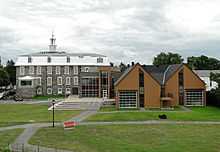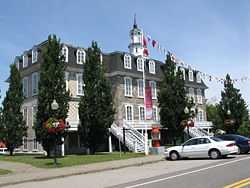Musée Maritime du Québec
| Musée Maritime du Québec | |
|---|---|
|
The Musée Maritime du Québec | |
| Established | 1968 |
| Location | L'Islet, Quebec |
| Coordinates | 47°07′43″N 70°22′17″W / 47.128677°N 70.371364°W |
| Collection size | 12,000 objects and documents |
| Visitors | 15,000 |
| Website | www.mmq.qc.ca |
The Musée Maritime du Québec (English: Maritime Museum of Québec, also known as the Musée Bernier) is a maritime museum located in the centre of the municipality of L'Islet in the Chaudière-Appalaches region of Quebec, Canada.
The museum consists of an outdoor park that includes three separate museum ships, a historic building with exhibitions on the theme of the sea and a hanger-workshop with exhibits on the building of small wooden ships and vessels.
Description
The museum is located in the municipality of L'Islet on the south shore of the St. Lawrence River, about 100 kilometres east of the Québec City.[1] The municipality has a rich maritime history, including the training of maritime navigators associated with the Canadian Merchant Navy.[2]
The museum's mission is to safeguard, enhance and enable the study of the maritime heritage related to the St. Lawrence River, from the Great Lakes to the high seas, including the Arctic territories.[3]
The museum was previously named as the Musée Bernier in honour of Captain Joseph-Elzéar Bernier (1852–1934), a L'Islet native and mariner with a history of exploration of the Canadian Arctic.[1]
History
Origins
The L'Islet region has a long maritime history dating to its New France period.[4] In 1853, the Christian Brothers created a school and taught maritime navigation. After a slow start, the school took the form of an "Industrial College" in 1873, better known today as the l'École des marins (School for sailors), providing seamanship training. It gains recognition for the practical aspects of such training. In 1920, many navigators trained at the school founded the Association for Sailors in the St. Lawrence Valley. They organize several exhibitions in the local maritime college and founded the museum in 1968, Canada's first maritime museum.[3]
The association wants to note the fact that this region of Quebec, in the valley southeast of the St. Lawrence River, which extends from Levis to Kamouraska, has had a busy shipbuilding industry during its 19th century, with over 2,000 vessels being built.[5] The museum was earlier called the 'Maritime Museum Bernier' in honor of Joseph-Elzéar Bernier (1852-1934), captain and Canadian explorer.[3] From its inception, the museum benefited from the help of local agencies and the Ministry of Culture of Quebec.[5] The support of the association and the citizens of the L'Islet permits the museum to collect hundreds of maritime objects in its early years, objects that form the core of its collection. It was recognized by the Ministry of Culture and Communications (Quebec) in 1975 and is the owner of National Maritime Collection of Quebec.[3]
Maritime park enlargement in 1983
In 1979 Canada Steamship Lines (CSL) donated the JE Bernier II, a maritime museum-boat which it had sponsored on a historic journey through the Northwest Passage in 1977. The museum acquired a second ship in 1980, the CCGS Ernest Lapointe, a Canadian Coast Guard icebreaker used on the Saint Lawrence River. In 1983 the museum acquired a third ship, the military hydrofoil HMCS Bras d'Or of the Canadian Forces Maritime Command, which became the world's fastest warship in the early 1970s.
In 1983, the museum expanded and underwent a major renovation to meet current museum standards.
In 1997, the museum began construction of the building of a hangar-workshop to house the collection of traditional small wooden boats. The project proved controversial among locals because of the architectural style of windowless building and its location west of the convent blocks the view of the river and its museum-ships. However, the museum's management said the site chosen was the only possible one and that the building could not use another location. The construction ended in June 1998 and the museum then processed a collection of 35 vessels from most maritime regions of Québec (Île d'Orléans, Île aux Coudres and Kamouraska).
In 2001, the museum received an award from the Québec Ministry of Tourism. This award recognized the efforts of the museum over the previous 33 years and invited visitors to make "an appointment with naval history" through its exhibits and its museum ships.
Continued expansion and new exhibits, 2009–2013
In January 2007, the museum received a grant CA$1.35 million from the Quebec Department of Culture and Communications to help its expansion plans and the preservation of its collections.[6] Financial assistance should also allow the museum to improve its reception area and its maintenance and repair of the main building. The total cost of the work is estimated at $2.25 million.[6] At the end of 2007 the Canadian government announced its participation in the project to the museum with a grant of $950,000.[7]

The expansion work and restoration of the museum are conducted in 2009-2010. Work began in September 2009 and are primarily intended to renovate the former convent building of the Surs du Bon-Pasteur and to expand the museum by adding a section between the convent and its chapel. For the old convent building the work consists of restoring its windows, masonry and roofing.[8]
The museum also takes possession of a former National Bank branch building located next to the convent, which is converted into a conservatory storage facility.[8] The storage areas located inside the convent significantly increase its display areas and make them more accessible to visitors, especially the its collection of some 200 boat models. The space recovered in the convent building increases the exhibition space and adds a screening room that will be used mainly for maritime heritage films.[8] Work was finally completed in July 2010.[9]
The total project cost is CA$4.4 million, with the Quebec government increasing its contribution to $3.05 million to allow completion of the work. The museum also helps finance the renovations with the participation of the J.E. Bernier Foundation, which contributed $250,000 in order to restore museum vessels. Other local agencies complete the financing of the project.
On 15 September 2010, the museum received an additional $500,000 for the construction of a new permanent exhibit. The permanent exhibits are to be fully restored and the grant will aid the interpretation of shipbuilding. The public should have access to the new exhibit in June 2013. From the summer of 2012 the museum will be open to visitors through guided tours.
References
- ↑ 1.0 1.1 Croteau, André; Trécarré (ed.) Les musées du Québec: 400 musées à visiter, Saint-Laurent, 1997, p. 37, ISBN 2-89249-764-7.
- ↑ Musée maritime du Québec. "Où nous trouver". Retrieved 20 June 2011.
- ↑ 3.0 3.1 3.2 3.3 Musée maritime du Québec. "À propos du musée". Retrieved 6 October 2010.
- ↑ Chassé, Sonia. La Vie maritime dans L'Islet, Saint-Jean-Port-Joli, Québec: Publications du Saint-Laurent, 1995, pp. 17–18, ISBN 2-9803620-3-4, OCLC 35933543.
- ↑ 5.0 5.1 Boulizon, Guy. Québec museums, Montreal: Fides, 1976, Vol. 2, pp. 157–160, ISBN 0-7755-0581-1, OCLC 715029312.
- ↑ 6.0 6.1 Government of Quebec. "La ministre Line Beauchamp accorde plus de 1,3 M$ au Musée maritime du Québec". Ministry of Culture, Communications and Status of Women. Retrieved February 12, 2011.
- ↑ Government of Canada. "Le gouvernement du Canada appuie le Musée maritime du Québec". Canadian Heritage. Retrieved February 12, 2011.
- ↑ 8.0 8.1 8.2 Émélie Soucy (30 October 2009). "Launch renovations at the Maritime Museum of Quebec". Tourisme Chaudière-Appalaches. Retrieved October 6, 2010.
- ↑ "Fin des travaux au Musée maritime du Québec". Le Placoteux. 16 July 2010. Retrieved October 13, 2010.
